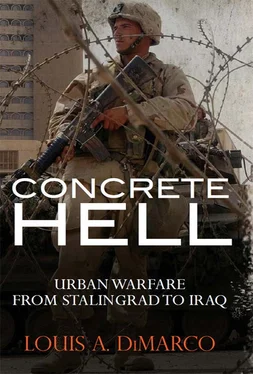Often urban operations were required to acquire a capability for future operations. This capability may have been an advance base, logistics facilities, or a harbor. In June and July 1758 during the Seven Years’ War, a 14,000-man British army under General Jeffery Amherst captured the French fortress city of Louisbourg on Cape Breton Island. This city was important as a North Atlantic base for the fleet and facilitated the blockade of French Canada. The capture of the city enabled British land and sea operations and greatly inhibited the operations of the French fleet in North America.
When defending, an army that was outnumbered often took advantage of the inherent defensive qualities of urban areas to compensate for its lack of numbers and to offset other advantages enjoyed by an enemy. In 1683, an outnumbered Christian force of approximately 20,000, under the command of the Holy Roman Empire, took shelter in, and defended, Vienna rather than meet an Ottoman army of 75,000 in open battle. The fortifications of the city permitted the outnumbered and less mobile European army to avoid defeat for two months until a relief force of 20,000 arrived to lift the siege and drive off the Turks. As the examples of Mexico City and Moscow indicate, urban operations did not always result in the desired outcome, even when tactical success was achieved and the city occupied. And, as the Turks found out at Vienna, offensive operations against cities often were not successful despite a significant commitment of resources. Thus, it behooved a commander to consider carefully whether urban operations were absolutely essential to the overall operation or campaign.
Occasionally, the commander could discover viable alternatives to the conduct of a deliberate urban operation. Oftentimes, the mere threat to a capital or key city was enough to compel its surrender. In the Franco-Prussian War, the French surrendered after the Prussians had laid siege to Paris but before an actual assault was mounted. Other times, the attacker could attempt a demonstration or ruse, or conduct a turning movement to entice the garrison of a city to fight in the open. A final technique attempted by armies whenever possible was to use surprise to capture a city before a defense could be organized. Attacking from an unexpected direction or by an unexpected means could achieve this.
British General James Wolfe used several techniques to achieve success and capture the French Canadian city of Quebec in 1759 without attacking it by the most obvious means. First, he achieved surprise and attacked from an unexpected direction by moving his army stealthily upriver from the city, conducting an amphibious landing by night, and scaling the supposedly inaccessible Heights of Abraham. By the morning of September 13, 1759, he had positioned his army in a double rank on the Plains of Abraham west of the city and astride Quebec’s supply lines. The brilliant and unexpected maneuver unnerved the French commander, Marquis de Montcalm, who decided to attack the British in the open without waiting for reinforcements. In the ensuing battle, British firepower routed the attacking French, destroyed French military capability and morale, and resulted in the city’s capitulation on September 18. In 1702, the Austrians also used surprise and an unexpected approach to capture the northern Italian city of Cremona by infiltrating elite troops into the defense by way of an aqueduct. In 1597, the Spanish captured the city of Amiens in northern France using a ruse. A small group of Spaniards disguised as peasants approached the city gateway, at which point they pretended that their cart had broken a wheel. In the confusion that followed, they rushed and captured the gate. These techniques entailed risk-taking and required boldness, imagination, and unique circumstances to be successful but avoided a costly and lengthy fight against the city’s defenses.
Bypassing the urban area was a viable technique; however, it had disadvantages. It required that the attacker tolerate the urban garrison in his rear and that he maintain sufficient forces to contain the threat of forays by the city garrison. Another effect of bypassing large important cities was that it often extended the political viability of the opposition and the duration of the campaign, thus jeopardizing the chance of a quick and decisive victory. The mounted Mongol armies that invaded the Chin Empire in northern China in 1211 were not very adept at the nuances of siege warfare and were forced to bypass important large, fortified population centers. The Mongols’ inability to conduct effective sieges was a major factor in the Chin’s ability to resist and sustain their empire for over two decades after the initial onslaught. Though rarely defeated in open battle, the vaunted Mongol cavalry did not fully conquer the Chin until 1234, after being aided in their efforts by allied Chinese generals and armies who provided experience in siege warfare.
Cities dominated the focus of war for most of history, playing a central role in the earliest campaigns in recorded history. The first battle in history of which there is any significant historical record was between the Hittites and the Egyptians in 1274 BC. The battle was fought outside the city gates of Kadesh, an important transportation hub in what is today modern Syria. Capturing or destroying the enemy’s major cities, and most importantly, their capital city, was the surest way to achieve victory in the ancient world. The Ancients also understood that the failure of such an attack could equal strategic defeat in the war. Therefore, the method of attack against a city was the subject of careful study and high-level discussion. Commanders very carefully considered whether to attack a city, how to attack a city, and conversely, how to defend one, before entering into battle. Attack against a city, a siege operation, was very meticulously planned before operations began.
For most of military history the importance of cities to warfare was demonstrated by large-scale siege operations. Even in ancient times, siege operations had developed into a finely honed and highly technical operation. Alexander the Great’s assault on Tyre in 332 BC utilized massive engineering efforts, amphibious landings, naval and land bombardments, and 150ft (45m) siege towers. Roman siege operations were likewise characterized by elaborate planning, sophisticated engineering efforts, and specialized equipment. The Romans and other ancient military forces were also very patient in their conduct of the operations and were often willing to invest years in order to successfully capture a city — capturing a city could be that decisive.
Engineering and engineers were central to planning urban operations. Engineering was the central component of ancient urban warfare. Cities were protected by walls and towers. Professional engineers designed these protective capabilities and chose where they would be built to offer the best protection for the city. Conversely, the attacker required professional engineers to evaluate the city’s defenses and develop a plan for attack. Central to that plan would be engineering equipment and capabilities. Ancient engineers developed specialized equipment and techniques to aid in the attack of the city. Equipment and techniques included battering rams, covers, ramps, tunnels, towers, ladders, and a variety of throwing machines.
Though some of the ancient specialized urban warfighting equipment was relatively simple, like battering rams, other pieces of equipment were very sophisticated and represented the cutting edge of technological capability of the time. Siege towers, which served a variety of purposes — from protected firing platform, to escalade launch vehicle, to battering ram support system — were particularly feared and complex. They could be over 100ft tall; they were usually completely mobile on their own set of wheels; they were protected against fire attacks, and all but the most powerful missile weapons; and they included their own bridge platforms (for passing troops from the tower to the wall) and firing systems (catapults and ballistae). In the Roman period, armies employed ballistae, a term which most people associate with the concept of a large-scale crossbow for firing large arrows. Ballistae were tactical powered weapons which could be mounted on city walls. However, most often they fired not arrows but small stones weighing up to 3lb, which could be extremely dangerous. The Romans used the ballista in the attack to suppress the enemy on the defensive city walls to allow friendly troops and towers to get in close for an assault. They were also mounted on siege towers and wheeled right up to the walls of the city.
Читать дальше












